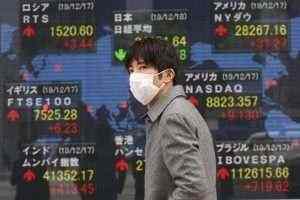

Dow himself never used the term Dow theory nor presented it as a trading system. Trend analysis is a technique used in technical analysis that attempts to predict future stock price movements based on recently observed trend data. Finally, minor trends are day-to-day price fluctuations in the market. It’s vital to remember that primary trend reversals can take months to present themselves—a change in price direction over a one-month, two-month, or even three-month period might only be a market correction. In such a paradigm, different market indices must confirm each other in terms of price action and volume patterns until trends reverse.

As new information arrives, market participants quickly disseminate the information and the price adjusts accordingly. Likewise, the market averages discount and reflect everything known by all stock market participants. 2) If TLT does not break up and both ETFs drop until the October 2022 lows are jointly pierced, the primary bear market will be reconfirmed, suggesting higher interest ahead.
What Is the Dow Theory?
The following chart of the Dow Industrials illustrates these three phases during the years leading up to the October 1987 crash. Alfred Cowles in a study in Econometrica in 1934 showed that trading based upon the editorial advice would have resulted in earning less than a buy-and-hold strategy using a well diversified portfolio. Cowles concluded that a buy-and-hold strategy produced 15.5% annualized returns from 1902 to 1929 while the Dow theory strategy produced annualized returns of 12%. Investopedia requires writers to use primary sources to support their work.
The Third phase is characterized by record corporate earnings and peak economic conditions. The general public (having had enough time to forget about their last «scathing») now feels comfortable participating in the stock market—fully convinced that the stock market is headed for the moon. It is during this phase that those few investors who did the aggressive buying during the First phase begin to liquidate their holdings in anticipation of a downturn. An individual stock’s price reflects everything that is known about the security.
An upward trend in Dow Theory is a series of successively higher peaks and troughs. A downward trend is a series of successively lower peaks and troughs. She holds a Bachelor of Science in Finance degree from Bridgewater State University and helps develop content strategies for financial brands.
Closing Prices and Line Ranges
The Dow Theory is the common ancestor to most principles of modern technical analysis. B) Market situation if one sticks to the traditional interpretation demanding at least three weeks of movement to declare a secondary reaction. A) Market situation if one appraises secondary reactions not bound by the three weeks dogma. A trending market is when a price series continually closes either higher or lower over a number of periods.
An inverse head and shoulders, also called a head and shoulders bottom, is inverted with the head and shoulders top used to predict reversals in downtrends. During an uptrend, a reversal occurs when the index consecutively fails to reach higher highs and higher lows over a long period. Instead, the index moves in a series of lower highs followed by lower lows.
The stock market discounts all newsStock prices quickly incorporate new information as soon as it becomes available. Once news is released, stock prices will change to reflect this new information. On this point, Dow theory agrees with one of the premises of the efficient-market hypothesis.
The reversal of a downward primary trend occurs when the market no longer falls to lower lows and highs. Consecutively higher highs and higher lows in a downward-trending market demonstrate a possible reversal to an upward trend. A reversal in the primary trend is signaled when the market cannot create successive peaks and troughs in the direction of the primary trend. The sixth tenet of Dow Theory contends that a trend remains in effect until there is a clear sign that the trend has reversed. Similarly, the market will continue to move in a primary direction until a force, such as a change in business conditions, is strong enough to change the direction of this primary move.
Trends exist until definitive signals prove that they have endedDow believed that trends existed despite «market noise». Markets might temporarily move in the direction opposite to the trend, but they will soon resume the prior move. The trend should be given the benefit of the doubt during these reversals. Determining whether a reversal is the start of a new trend or a temporary movement in the current trend is not easy. Technical analysis tools attempt to clarify this but they can be interpreted differently by different investors. Another feature in Dow Theory is the idea of line ranges, also referred to as trading ranges in other areas of technical analysis.
Volume Must Confirm the Trend
It is comprised of three primary trends, each made up of secondary and minor trends. The theory assumes that the market already has knowledge of every possible factor and that prices reflect current information. This implies that there is no need to investigate further why assets are priced the way they are but to act on price movements and volume and depend on signals and confirmation for trend reversals.
What Are the 3 Trends of the Dow Theory?
When prices move on low volume, there could be many different explanations. But when price movements are accompanied by high volume, Dow believed this represented the «true» market view. If many participants are active in a particular security, and the price moves significantly in one direction, Dow maintained that this was the direction in which the market anticipated continued movement. One of the main techniques used to identify trend reversals in Dow Theory is peak-and-trough analysis. Apeakis defined as the highest price of a market movement in a period, while atroughis seen as the lowest price of a market movement in a period.
Understanding the Dow Theory
According to this logic, if manufacturers’ profits are rising, it follows that they are producing more. If they produce more, then they have to ship more goods to consumers. Hence, if an investor is looking for signs of health in manufacturers, he or she should look at the performance of the companies that ship their output to market, the railroads. The index contains major railroads, shipping companies, and air freight carriers in the US. Trends are confirmed by volumeDow believed that volume confirmed price trends.
The Dow Theory holds that, since stock prices over the short-term are subject to some degree of manipulation , Minor trends are unimportant and can be misleading. This blog (dowtheoryinvestment.com) is strictly a personal journal applying my interpretation of Dow Theory principles to the action of the stock market and my musings about investment and trading in general. This blog is intended solely for entertaining, illustrative or informational purposes. I am unaware of any readers personal circumstance, financial condition, risk tolerance or goals and objectives, so nothing read here should be considered advice suitable for them. Anyone reading this blog does so with the understanding that this is strictly meant as an analytical exercise and does not proffer actionable advice in any way, shape or form. Trading and investing always entail risk and possible loss of funds and should only be undertaken after appropriate due diligence by the trader/investor and after consulting a registered investment adviser.
Secondary trends are intermediate, corrective reactions to the Primary trend. These reactions typically last from one to three months and retrace from one-third to two-thirds of the previous Secondary trend. The following chart shows a Primary trend (Line «A») and two Secondary trends («B» and «C»). The overall goal of the Dow Theory is to identify the market’s primary trend through proof and confirmation. Charles Dow relied solely on closing prices and was not concerned about the intraday movements of the index.
Stock market averages must confirm each otherIn Dow’s time, the US was a growing industrial power. The US had population centers but factories were scattered throughout the country. Dow’s first stock averages were an index of industrial companies and rail companies. To Dow, a bull market in industrials could not occur unless the railway average rallied as well, usually first.
If the primary trend is down, volume should increase during market declines. If the primary trend is up,volume should increase during market advances. Confirmation of the change in trend occurred when both averages rose above their previous secondary peak.
If selling volume picks up during a pullback, it could be a sign that more market participants are turning bearish. The market has three movements The «main movement», primary movement or major trend may last from less than a year to several years. The «short swing» or minor movement varies with opinion from hours to a month or more. The three movements may be simultaneous, for instance, a daily minor movement in a bearish secondary reaction in a bullish primary movement.
Reversals in primary trends can be confused with secondary trends. It is difficult to determine whether an upswing in a bear market is a reversal or a short-lived rally followed by still lower lows. The Dow Theory advocates caution, insisting that a possible reversal be confirmed by comparing indexes.
The Dow Theory operates on the efficient market hypothesis , which states that asset prices incorporate all available information. An up-trend is defined by a series of higher-highs and higher-lows. In order for an up-trend to reverse, prices must have at least one lower high and one lower low . The following chart shows expanding volume during an up trend, confirming the primary trend. The Dow Theory says that the First phase is made up of aggressive buying by informed investors in anticipation of economic recovery and long-term growth.